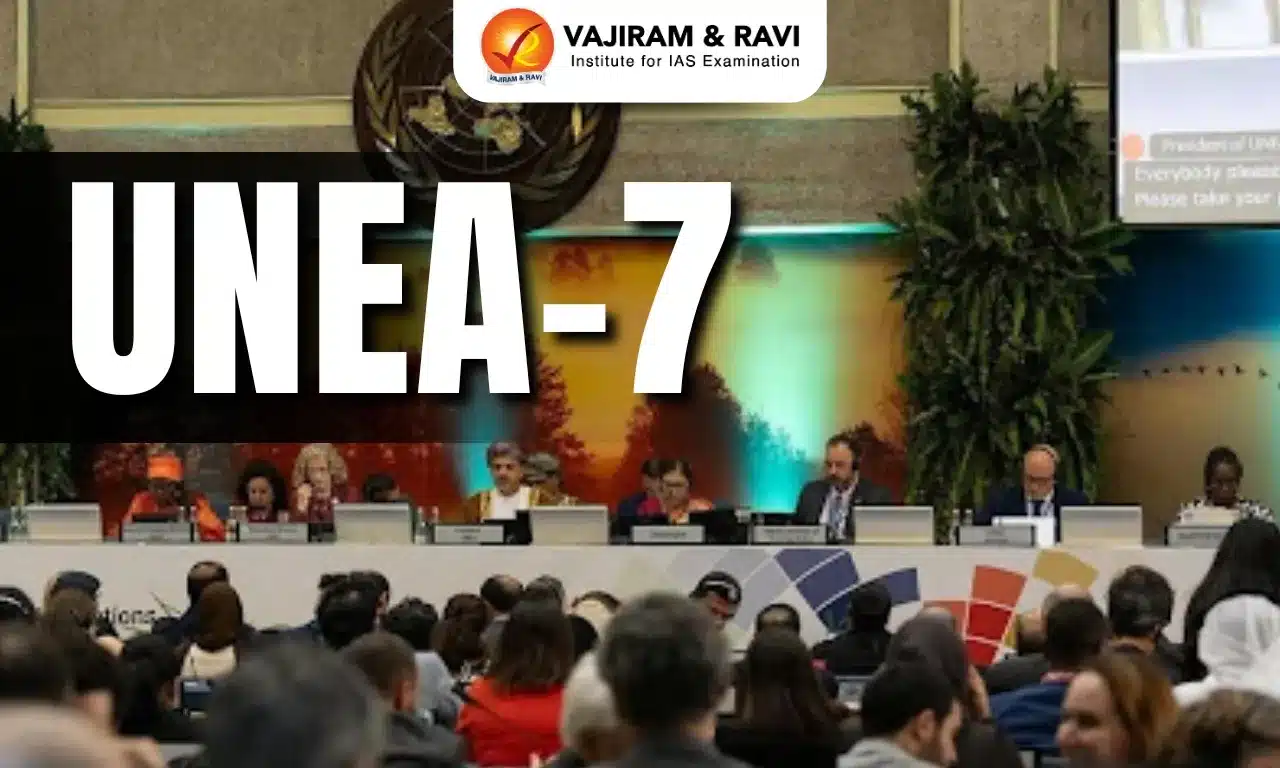What’s in today’s article?
- Why in news?
- What is Internationalisation of the rupee?
- What is Special Drawing Rights (SDR)?
- News Summary: RBI panel recommends measures for internationalisation of rupee
- Key highlights: RBI panel recommends measures for internationalisation of rupee
Why in news?
- A Reserve Bank of India-appointed working group recommended various measures to accelerate the pace of internationalisation of the rupee.
- This included inclusion of the rupee in the Special Drawing Rights (SDR) basket and recalibration of the foreign portfolio investor (FPI) regime.
What is Internationalisation of the rupee?
- About
- Internationalisation of the rupee is a process that involves increasing use of the local currency in cross-border transactions.
- Basically, it is a process of promoting and increasing the use of the INR as a widely accepted currency for international transactions and investments.
- It involves enhancing the currency’s acceptance, liquidity, and usability in global markets.
- Steps taken to promote international trade settlement in rupees
- In July 2022, the RBI has provided an additional arrangement for invoicing, payment, and settlement of exports/imports in the rupee.
- As part of this mechanism, in December 2022, India saw its first settlement of foreign trade in rupee with Russia.
- So far banks of 19 countries including the UK, New Zealand, Germany, Malaysia, Israel, and the United Arab Emirates have been permitted to make settlements in rupees.
What is Special Drawing Rights (SDR)?
- About
- The SDR is an international reserve asset, created by the IMF in 1969 to supplement its member countries’ official reserves.
- The IMF uses SDRs for internal accounting purposes.
- It should be noted that SDRs are neither a currency nor a financial claim on the IMF.
- SDRs are a potential claim of IMF members on freely usable currencies.
- Basket of currencies determining the value of the SDR
- The value of the SDR is based on a basket of five currencies.
- These currencies are – the U.S. dollar, the euro, the Chinese renminbi, the Japanese yen, and the British pound sterling.
- Currencies included in the SDR basket have to meet two criteria: the export criterion and the freely usable criterion.
- The value of the SDR is determined on daily basis. It is based on weighted market exchange rates of the basket currencies.
- SDR Allocation
- SDRs are allocated to each of the countries that are IMF members.
- The amount of SDRs that are allocated to each country is based on their individual IMF quotas.
- IMF quotas are based broadly on the relative economic position of the country in the world economy.
- The quota is essentially a country’s financial commitment to the IMF and its voting power.
- The IMF determines whether there is a need for a new allocation of SDRs in the global economy every five years.
- The recent allocation was done in August 2021.
News Summary: RBI panel recommends measures for internationalisation of rupee
- A Reserve Bank of India-appointed working group recommended various measures to accelerate the pace of internationalisation of the rupee.
- The recommendations by an Inter-Departmental Group headed by RBI Executive Director Radha Shyam Ratho.
- The group was constituted by RBI Deputy Governor T Rabi Sankar to:
- review the position of the rupee as an international currency and
- to frame a road map for the internationalisation of the domestic currency.
Key highlights: RBI panel recommends measures for internationalisation of rupee
- Rupee has the potential to become an internationalised currency
- India is one of the fastest growing countries and has shown remarkable resilience even in the face of major headwinds.
- Higher usage of the rupee in invoicing and settlement of international trade, as well as in capital account transactions, will give the domestic current a progressively international presence.
- Rupee as a designated foreign currency
- The recent decision by Sri Lanka to formally include the rupee as a designated foreign currency augur well for incremental internationalisation of the domestic currency.
- For a long time, India has maintained currency arrangements with Bhutan and Nepal involving the rupee.
- The recent decision by Sri Lanka to formally include the rupee as a designated foreign currency augur well for incremental internationalisation of the domestic currency.
- Suggestions given by the group
- As part of the long -term measures to achieve internationalisation of the rupee, the group suggested inclusion of the rupee in SDR basket.
- For short term measures, it recommended use of the existing bilateral and multilateral payment and settlement mechanisms, such as ACU (Asian Clearing Union), to internationalise the rupee.
- ACU is a regional payment and settlement system that facilitates trade and financial transactions among member countries in Asia.
- It was established in 1974 with the aim of promoting intra-regional trade and enhancing economic cooperation among its members.
- Members – Bangladesh, Bhutan, India, Iran, Myanmar, Nepal, Pakistan, the Maldives, and Sri Lanka.
- Non-residents should be allowed to open rupee account.
- The ability to open accounts outside the country of the currency is a foundational element of the internationalisation of a currency.
- The RBI should also look at expanding the footprint of rupee denominated payment mechanism.
- It should step up measures for the inclusion of Indian Government Bonds (IGBs) in global bond indices.
- Also, rationalisation of the FPI regime is needed to facilitate a more conducive environment for foreign investments into the Indian debt markets (both government and corporate).
- For the medium term, the group recommended:
- review of withholding tax for masala bonds issuances;
- Masala bonds are debt instruments issued by Indian entities in the international market but denominated in Indian rupees.
- expansion of RTGS (Real Time Gross Settlement) system for settling international transactions; and
- inclusion of the rupee in Continuous Linked Settlement (CLS) system.
- CLS system is a financial market infrastructure that provides a settlement service for foreign exchange (FX) transactions.
- It was established in 2002 to mitigate the settlement risk associated with FX trades.
- review of withholding tax for masala bonds issuances;
Q1) What are masala bonds?
Masala bonds, also known as rupee-denominated bonds, are debt instruments issued by non-Indian entities in the international market but denominated in Indian rupees (INR). The term “masala” is derived from the Indian cuisine, symbolizing the bond’s connection to India. Masala bonds provide a means for foreign entities to raise funds in Indian currency from global investors. These bonds are typically listed on international exchanges, allowing investors outside of India to participate in the Indian debt market.
Q2) What is Continuous Linked Settlement (CLS) system?
The Continuous Linked Settlement (CLS) system is a global financial infrastructure that provides secure and efficient settlement services for foreign exchange (FX) transactions. It was established to mitigate settlement risk in the FX market and enhance stability in the global financial system.
Source: RBI panel recommends measures for internationalisation of rupee | IMF | Indian Express | The Wire | Business Insider
Last updated on December, 2025
→ Check out the latest UPSC Syllabus 2026 here.
→ Join Vajiram & Ravi’s Interview Guidance Programme for expert help to crack your final UPSC stage.
→ UPSC Mains Result 2025 is now out.
→ UPSC Notification 2026 is scheduled to be released on January 14, 2026.
→ UPSC Calendar 2026 is released on 15th May, 2025.
→ The UPSC Vacancy 2025 were released 1129, out of which 979 were for UPSC CSE and remaining 150 are for UPSC IFoS.
→ UPSC Prelims 2026 will be conducted on 24th May, 2026 & UPSC Mains 2026 will be conducted on 21st August 2026.
→ The UPSC Selection Process is of 3 stages-Prelims, Mains and Interview.
→ UPSC Result 2024 is released with latest UPSC Marksheet 2024. Check Now!
→ UPSC Prelims Result 2025 is out now for the CSE held on 25 May 2025.
→ UPSC Toppers List 2024 is released now. Shakti Dubey is UPSC AIR 1 2024 Topper.
→ UPSC Prelims Question Paper 2025 and Unofficial Prelims Answer Key 2025 are available now.
→ UPSC Mains Question Paper 2025 is out for Essay, GS 1, 2, 3 & GS 4.
→ UPSC Mains Indian Language Question Paper 2025 is now out.
→ UPSC Mains Optional Question Paper 2025 is now out.
→ Also check Best IAS Coaching in Delhi

















